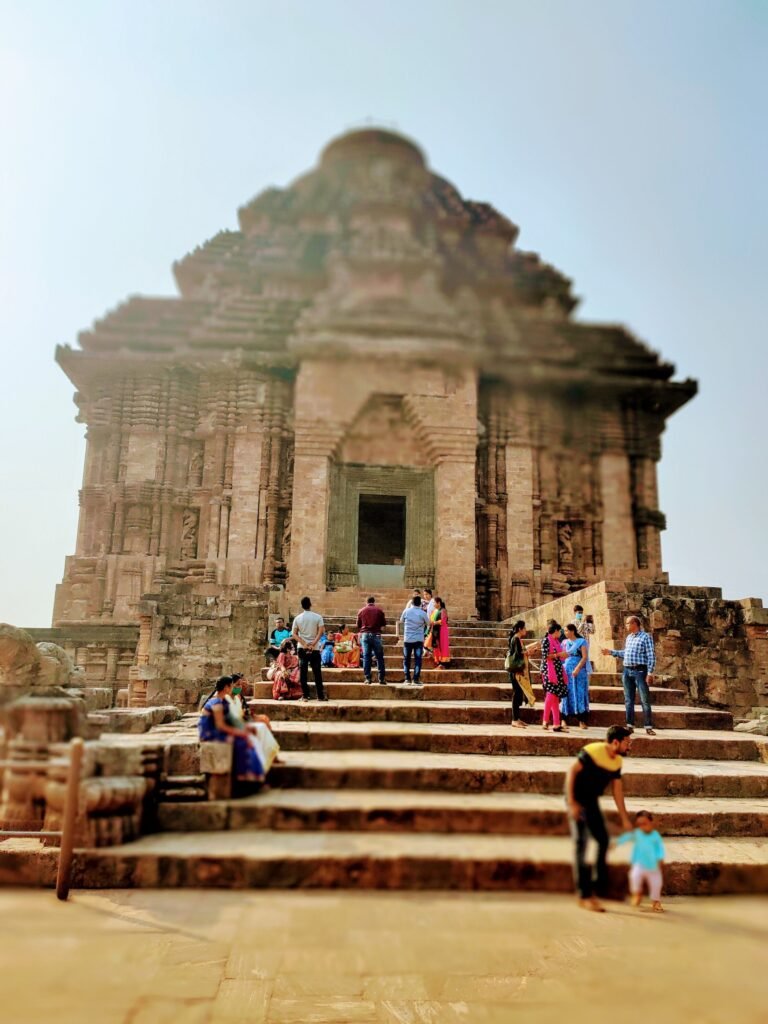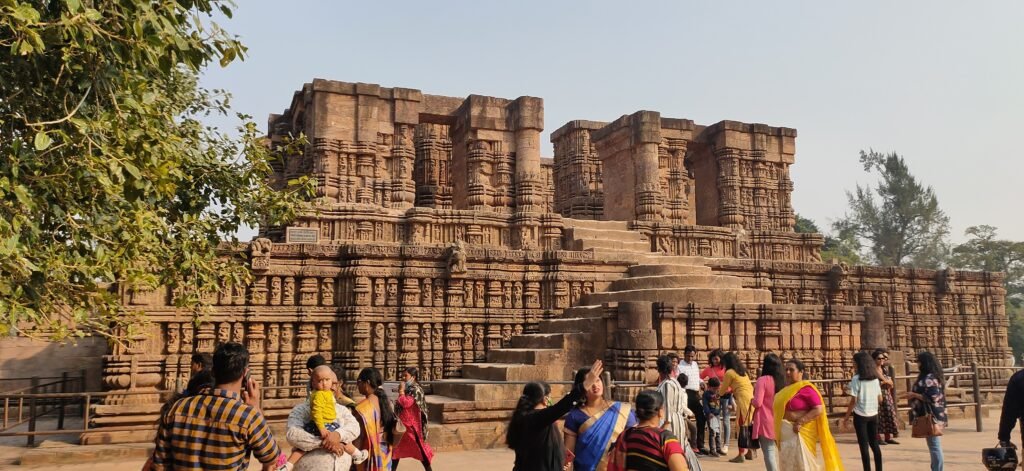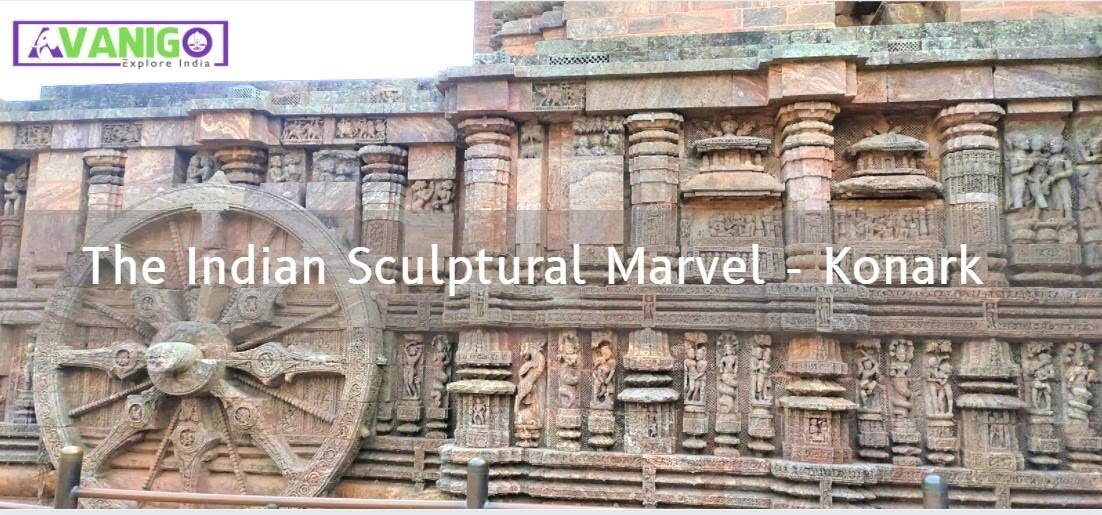The Sun temple of Konark is a majestic construction that stands alive as proof of ancient Indian architecture. One of the famous tourist places in Odisha and India, the Konark Sun Temple seems as mysterious as magnificent it is. Interestingly, the Jagannath Puri Temple, Konark Temple, and the Lingaraja temple seem to be interconnected in many ways. As we move ahead in this post, let us explore the mysterious beauty and magnificence of the Konark temple.
Quick Navigation
Konark Sun Temple History
Sun is one of the prime divinities in Indian Culture. Praying Surya Bhagwan is an age-less practice in India practiced in Vedic times. This manifested as Surya Namaskar, which is a powerful asana in yoga.
Sun temple is an abode built for pious rituals and religious activities for offering prayers and sacrifices to Surya, built by various communities across various nations like India, Japan, Peru, Egypt, and China.
Konark Temple is one such Sun Temple of India located in the small town of Konark in Odisha. It is located 35Kms northeast of the pious town – Puri.
The history of the Konark temple dates back to C.AD 1250. The Konark Mandir was built as a mark of respect and to celebrate Sun God Surya. King Narasimha Deva was the ruler behind the construction of this architectural marvel. Spanning an area of around 26 acres, the wide campus of Konark contains many components.
Sun God’s statue on a celestial chariot with 24 helms drawn by 7-horse cavalry is distinctive in Konark Temple. UNESCO declared it a World Heritage site in 1988. It is renowned as Black Pagoda as the sanctuary appears darkish due to its construction from black granite.
A fascinating age-old saying is that mariners had a conviction that it hauls the vessels to the coastline thereby banging them on the temple edifice landing on creating debris.
“Konark”- the name sprouts from the blend of two words “Kona” and “ark”. “Kona” means mathematical angle, and “ark” is the Sanskrit name of Lord Surya. Together, Konark means the Sun’s abode.
The Sun Temple of Konark is recognized as one of the prime tourist attractions of Odisha. It is one of the temples in the Golden Triangle of Odisha featuring the Jagannath Temple of Puri and the Lingaraj Temple of Bhubaneswar. Interestingly, a trip to Konark temple seems incomplete without visiting two of the richest temples of India – The Puri Jagannath Temple and Lingaraja Temple.
Construction of Konark Sun Temple
The massive Konark Sun Temple of India was built by the emperor NarasimhaDeva1 of the Eastern Ganga empire. He intended to rejoice in his victory over the Muslim troops and he dedicated this Konark mandir to the Sun God as he considered himself as a great disciple of the Sun god.
The whole of Konark mandir is artistically fabricated, representing the Sun God riding on a celestial chariot driven by 24 large helms (12 on one side) pulled by 7 mighty horses.
It is believed that it took altogether 12 years and 12 years of the empire’s revenue to construct such a massive Surya temple. Interesting to note that, it is believed that 7 horses denote the 7 weekdays 24 helms symbolize 24 hours in a day and 12helms on one side epitomizes 12 months in a year.
The temple stands tall at 100 feet elevation at present which is half of its original height when the shikhara was at an altitude of 200 feet.
India Republic Day Celebration Ideas

The structural design of the Konark Sun Temple of India
At the entrance of the Konark mandir, we can find two big lions subduing the elephants over a human. It has an axiom attached to it which signifies that every lion signifies the vanity of a human being and the elephant denotes coinage. Coinage and Vanity together can destroy a human being. So true to this age.
Amid the large open area there lies the broken main temple (Deula) and the Jagamohana(portico)on an elevated floor. Around the raised floor are the 24 huge helms 12 inches in diameter with 8 spines so intricately carved that to date can keep one enchanted.
Spines on the helms intriguingly depict time almost accurately. It divides the time into a 3-hour zone which in earlier days were referred to as prahars and we have 4 prahars in a day. 8 minor spines are spotted each midway between the two main helms. The 24 helms celestial chariot seems to be pulled by the seven powerful horses, crafted out of a single stone, in the eastward direction towards the sea.
The Deula is enveloped by various sanctums and figurines carved magnificently. Deula and the Jagamohana denote the lower part of the celestial chariot. There is an open space for dance (Natamandir) leading to the Jagamohana and also can be located in the vicinity, of the dining space ( Bhog Mandap).
Chhaya Devi(Maya Devi)Temple is there in the southwestern area and she is considered to be the favorite associate of the Sun God.
In the Navagraha Shrine there lies a massive stone pane showing images portraying the nine planets of the solar system. Majestic horses and elephants can be seen on both sides of the central temple.
Suggested Reading: Significance of Elephants in Indian Culture
Konark Sun Temple Architecture
The Sculptors of Odisha exhibited their skills unmatched in sculpting the sun god temple such that the first rays of the sun are incident on the sculpt of the Surya Bhagwan kept on a pedestal inside the central temple and then is distributed through the doors.
On the temple walls, we can find different lifeforms like animals, and birds, along with men and women in various acts like dancing, hunting, and Kamasutra positions indicating the lifestyle of the people then.
Such carvings can also be seen engraved in the unsurpassed statuettes all around the confines of the temple. Even the artistically embossed celestial figurines should not be missed to be watched in the confines. Angkor Wat becomes the 8th Wonder of the World
There are three sun idols on the three sides of the temple except the east side encrypted out of metallic green chlorite rock which validates the craftsperson’s skills in making this unique and different from all other crafts work of the temple, yet it does not stand out of the assembly. It has to be seen to believe it.
Another unique feature of its fabrication is that iron beams were used between the two stones and a 52-ton magnet was used to erect the shrine’s uppermost part. However, the temple could withstand the blow from the river waters and climate for so long is enough proof of the skill and manship of the artisans.

Konark Sun Temple Legend
The chief artisan of the Konark Sun Temple of India was Bishu Maharana leading 1200 workers under him. King Narasimhadeva I had ordered to finish the erection work within a stipulated time.
But, one day before the day of completion, the topmost stone Dadhi Nauti (Pagoda) of the temple fell. This caused distress for Bishu Maharana as the King administered punishment to all the 1200 workforce. Meanwhile, the 12-year-old son of Bishu Maharana, Dharmapada, went up to him and with his permission fixed the stone again.
But the fact that a boy of 12 years did the task that 1200 workers could not do would attract punishment from the king when he discovered it. On hearing these words from his father, Dharmapada leaped from the pagoda after placing it back, into the waters of Chandrabhaga River flowing nearby and ended his life to save the lives of all 1200 workforce.
It is presumed that Dharmapada was the element of the Sun God who came into existence to crush the king’s ego. At last, the temple construction was completed in 12 years.
The Downfall of Konark Temple
The Konark Sun Temple and its superb structural design attract visitors from every part of the world. Every year thousands of art and architecture lovers visit this evergreen beauty.
As per the local tales, one of the Muslim Commanders referred to as Kalapahad by the people attacked Odisha in 1508. They went on destroying most of the Hindu temples, including the Konark Temple.
Some other belief systems depict that the huge magnet used to construct the shrine’s pinnacle leads to magnetizing the vessels towards it leading to the destruction of the temple.
The incomplete infrastructure of the Sun Temple at Konark also is accredited to its downfall by some historians.
Despite the legends and the mystery of the Konark temple, even today, it has its unique identity and draws global tourists.

Konark Sun Temple Dance Festival
Konark Dance Festival is one of the grand dance festivals of the state as well as the country. Every year Konark Temple Dance Festival is planned for 5 days in December in the Natya mandap (Dance Space) of the temple. This is an initiative to maintain the Odissi culture. The Konark dance festival binds the dancers and artists to their roots.
During this Konark dance festival season, thousands of dancers and dance lovers throng this architectural town to experience the elegant structural design of Konark Temple and cherish the rich cultural heritage of the state.
Read more: Karnataka Culture and Dances You Should Know
Archaeological Impressions
Over the years, the water of the Chandrabhaga River subsided gradually. Today there is no river near Konark Temple. What remained was the sand in all places that engulfed the Konark Temple until it was recovered by the Britishers.
In 1837, James Ferguson was the first person to exhume the Konark sun temple. Currently, it is somewhat in carcasses and some of its figurines are housed in the Sun Museum run by the ASI.
The conservation of the Konark sun temple is in the hands of ASI and they are in operation towards its preservation.
Konark Sun Temple stands for its uniqueness in all its aspects; if not preserved now, then it will be too late to uphold our heritage.
Konark Temple Images


Frequently Asked Questions
Konark temple was built by the emperor NarasimhaDeva1 of the Eastern Ganga empire.
Sun temple in India is in Konark town of Odisha state.
The Sun Temple is famous for its unmatchable sculptural display as well the legends behind it.
Sun Temple ticket price for Indians is Rs. 40 and for foreigners is Rs.600.
Konark Sun Temple is open from 10:00 am to 5:00 pm for tourists.
Konark temple is in the town of Konark, near Puri town in Odisha.
There are 2 sun temples in India – One in Konark, Odisha, and another in Modhera, Gujarat.

